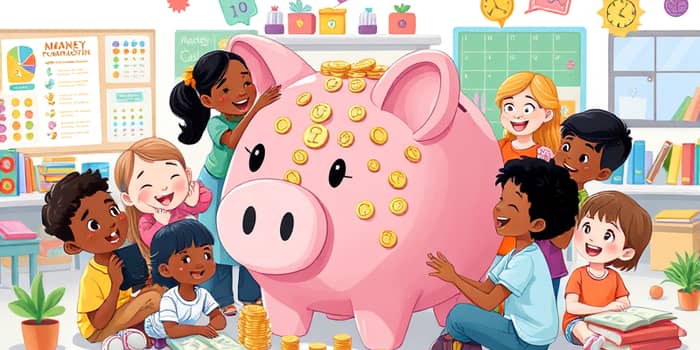Teaching children about money from a young age is more than an educational trend—it is an urgent social imperative. With financial pressures mounting and economic landscapes shifting, early literacy can pave the way for lifelong resilience, responsible decision-making, and genuine empowerment.
Understanding the Urgent Need
Recent data reveals that only 35.2% of young adults aged 18–24 demonstrate basic money management skills. Gen Z, in particular, scores an average of 38% on national literacy tests, highlighting a profound gap before young people even enter the workforce. At the same time, 65% of Americans live paycheck to paycheck, and fewer than half can cover a $1,000 emergency from savings.
- Build lifelong money management habits begin with early guidance.
- Only 16 states require stand-alone finance courses.
- Family remains the primary educator for 75% of teens.
These sobering statistics remind us that waiting until college or adulthood is too late. When children learn to manage pennies and understanding the value of choices as early as elementary school, they develop a mindset that translates into adulthood. By introducing simple exercises, like sorting coins or deciding whether to save or spend, parents and teachers can light a spark that leads to lifelong financial wellness and security.
The State of Financial Education in Schools
While momentum is growing—27 states now mandate personal finance for graduation—implementation remains uneven. Only 10 have fully rolled out required courses for all students, and many schools still embed lessons within unrelated subjects. This patchwork approach perpetuates wide regional and socioeconomic disparities.
Behind these legislative efforts lie compelling stories of communities striving to equip every graduate with practical money skills. Educators report that students who complete dedicated courses show greater confidence in budgeting, planning, and setting realistic goals.
Without consistent standards, millions of students miss the chance to build financial confidence and independence before adulthood.
Empowering every school with clear benchmarks can drive future economic stability and growth across the nation.
Where Children Learn About Money
In the absence of robust school programs, most young people turn to family, peers, or social media. While 38% of Americans credit their family for money lessons, only 15% learned about personal finance in school. Meanwhile, approximately 70% of Gen Z adults seek tips on TikTok or YouTube, although content quality often varies dramatically.
- Interactive games and tools can fill gaps.
- 54% of teens express an appetite for more classroom instruction.
- Parental modeling shapes attitudes toward saving and spending.
While digital platforms can democratize access, the flood of unverified tips and viral trends can mislead. Parents and educators must guide young people toward credible sources and reinforce critical thinking skills. Cultivating discernment early builds resilient financial decision-making skills.
Essential Financial Skills by Age
Developing a curriculum that evolves with a child’s cognitive growth ensures concepts stick. Early elementary learners thrive on tangible activities, while high school students engage with real-world scenarios.
- Early Years: Needs versus wants, recognizing coins, basic saving goals.
- Middle School: Budgeting exercises, tracking expenses, introductory banking.
- High School: Credit fundamentals, investing simulations, tax deductions, risk management.
By layering complexity over time, educators build a foundation for smart decision-making and future financial health.
Overcoming Barriers in Vulnerable Communities
Low-income and minority families face unique challenges: only 23% of low-income adults are financially literate, and informal borrowing can compound economic stress. Community-based programs have demonstrated success, boosting budgeting skills by 21% and emergency savings by 14% among participants. SNAP recipients receiving financial coaching were 28% more likely to reduce food insecurity.
Integrating tailored workshops, mobile banking initiatives, and community and non-profit programs can deliver targeted support where it is needed most.
Empowering educators in under-resourced schools with targeted toolkits and hands-on community partnerships and workshops can level the playing field. When young learners have real-life examples—visits from local bankers, interactive budgeting fairs—they gain context that sticks long after the lesson ends.
Best Practices for Educators and Parents
Evidence underscores the power of engagement and consistency. When parents actively participate, children reinforce lessons and adopt healthy money habits alongside their families. Schools that utilize game-based platforms like Banzai or Next Gen Personal Finance reach nearly 10 million students, producing measurable gains in knowledge and behavior.
- Start early with allowances and saving jars.
- Use age-appropriate games to reinforce concepts.
- structured, evidence-based curriculum in schools for all grade levels.
- Encourage regular family discussions about money goals.
Frequent, open discussions about money demystify taboo topics and build trust. Setting aside a weekly family finance check-in transforms financial literacy from an abstract school exercise into a family value. With each conversation, parental involvement magnifies learning outcomes.
Building a Brighter Financial Future
Imagine a future where every teenager submits a balanced budget instead of defaulting on credit cards, where parents celebrate their children’s financial wins as proud milestones. This vision is within reach when stakeholders unite behind a shared goal of accessible, high-quality financial education for all.
By advocating for comprehensive school mandates, investing in engaging tools, and fostering open dialogues at home, communities can ensure that every child has the chance to master money. Together, we can transform stress into security and pave the way for a more equitable, confident generation.
References
- https://coinlaw.io/financial-literacy-statistics/
- https://www.aba.com/about-us/press-room/press-releases/new-survey-americans-support-financial-education-in-schools
- https://cricketmedia.com/news-press/crickettogether-news-resources/building-money-smarts-how-early-financial-education-empowers-the-next-generation/
- https://carry.com/learn/how-financially-literate-is-america-key-stats
- https://excelined.org/2025/03/04/financial-literacy-education-in-the-united-states-landscape-analysis-and-next-steps/
- https://www.weforum.org/stories/2025/07/financial-education-students-to-parents/
- https://lifestepsusa.org/financial-education-programs-for-youth/
- https://www.ngpf.org/blog/advocacy/insights-from-the-2025-state-of-financial-education-report/










